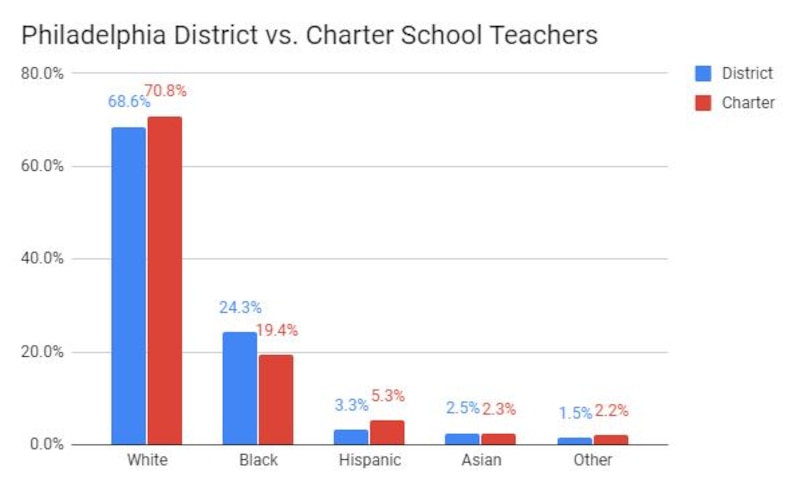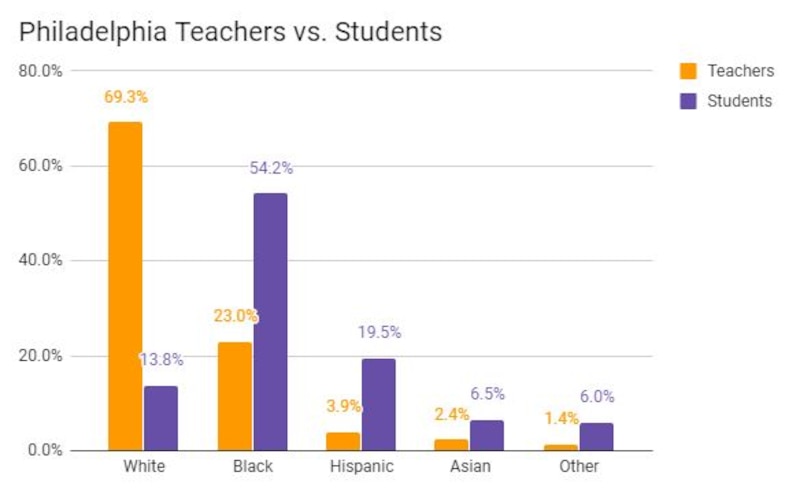This article was originally published in The Notebook. In August 2020, The Notebook became Chalkbeat Philadelphia.
The typical Philadelphia teacher is a white woman with a bachelor’s degree, about a decade of teaching experience, and a median annual salary of $63,000, an analysis of the city’s workforce shows.
This portrait is based on the Pennsylvania Department of Education’s 2016-17 demographic data on all personnel in public education. The Notebook has examined the general characteristics of the Philadelphia teaching force derived from the data, which include background information on all District and charter school educators, such as gender, annual salary, and years of experience.
Racial data is not included in the online data, but was provided via email after the Notebook submitted a Right-to-Know request to the Pennsylvania Department of Education. Research for Action (RFA), a nonprofit education research organization, provided technical assistance for data analysis.
The Notebook, with RFA and WHYY’s Keystone Crossroads, will be analyzing teacher data in Philadelphia and across the state to illuminate trends in the teacher workforce.
Among the findings: Teachers in District schools have an average of seven more years of experience than those in charter schools. In the city, two-thirds of full-time teachers work in District schools and one-third in charter schools, roughly reflecting the breakdown of student enrollment.
Besides having more experience, District teachers generally receive higher pay than charter school teachers. The median annual salary of District teachers is $67,800, while that of charter school teachers is $51,000.
District teachers are paid according to a salary schedule developed through collective bargaining by the Philadelphia Federation of Teachers that considers education level, certification, and experience.
Charter school teachers, however, are usually not unionized and instead are paid according to their schools’ own policies. In particular, teachers at Mastery Charter, which operates 18 schools in Philadelphia, earn $13,300 more than teachers in other charter schools, despite having an average of two years less experience.
“Each individual charter school has their own system, I suppose. But what I can tell you is up to 25 percent of their teachers don’t have to hold a teaching certificate,” said Arlene Kempin, executive vice president of the Philadelphia Federation of Teachers.
Pennsylvania’s charter law allows charter schools to have up to 25 percent non-state-certified teachers, though these teachers must meet the state’s basic requirements and demonstrate sufficient competence in their subject areas.

Data from the Pennsylvania Department of Education, 2016-17
The racial makeups of District and charter schools are also slightly different. District schools have a higher proportion of black teachers (24 percent vs. 19 percent), while charter schools have a slightly higher proportion of Hispanic teachers (5 percent vs. 3 percent).
Overall, the teaching force in Philadelphia District and charter schools is 70 percent white and 23 percent black. This does not reflect the city’s demographics: 35 percent of Philadelphians are white and 44 percent are black. Other races are underrepresented as well – Philadelphia is 15 percent Hispanic and 8 percent Asian, but its teachers are 4 percent Hispanic and 2 percent Asian.

Data from the Pennsylvania Department of Education, 2016-17
The demographic composition of Philadelphia teachers is even more out of sync with student enrollment, which in District and charter schools is 14 percent white, 54 percent black, 20 percent Hispanic, 7 percent Asian, and 6 percent multiracial and other.
Compared to teachers, there is a more equal representation of white and black school administrators in Philadelphia, with 45 percent of administrators being white and 44 percent black. But other ethnic groups are still underrepresented – 7 percent of administrators are Hispanic and 2 percent are Asian.
Statewide, almost 95 percent of teachers are white and just 4 percent are black. Philadelphia alone has 42 percent of the state’s black students and 62 percent of its black teachers.
Barbara Goodman, communications director for the American Federation of Teachers (AFT) Pennsylvania, said that this is symptomatic of a broader teacher shortage, especially among minorities.
“I think it’s a much bigger problem than Philadelphia not having enough African American or Hispanic teachers,” she said. “This country doesn’t have enough teachers and [teaching] is not a diverse workforce because it isn’t a particularly attractive profession to go into.”
The number of teaching certifications issued by PDE has been declining since 2012. Between the 2015 and 2016 school years, Pennsylvania saw a 45 percent decrease in certifications issued – the biggest one-year decrease in the last five years.
Although the number of minority teachers has grown rapidly across the country since the 1980s, minority teachers have higher attrition rates, which could explain why they remain underrepresented despite targeted recruitment efforts.
“Minority teachers are disproportionately employed in these large, urban school districts, often serving low-income communities,” said Richard Ingersoll, professor of education and sociology at the University of Pennsylvania.
“Those schools have higher quit rates for all teachers, and because minority teachers are disproportionately employed in them, this results in [minority teachers] having higher-than-average quit rates,” he explained.
In Philadelphia, the proportion of black teachers has declined from about 34 percent in 2001 to 23 percent now.
Teaching is historically a female-dominated profession, and that remains true in Philadelphia, where more than 70 percent of teachers are women, even though women today have more career options than they did in the past.
After adjusting for education level and experience, there are small discrepancies in annual salary between female and male teachers.
In District schools, female teachers earn around $600 less than male teachers annually. This may be because male teachers tend to take on more time-consuming extracurricular responsibilities, such as coaching sports teams or being roster chairs.
Recent research by the University of North Carolina revealed that despite salary schedules, female public school teachers in Pennsylvania are paid $500 less than their male counterparts, even though the state’s teaching force is majority female.
Another picture emerges in charter schools: Female teachers with a bachelor’s degree earn on average $300 more than their male counterparts, but those with a master’s degree earn $160 less.
Compared to District teachers, charter school teachers have more varied education levels, years of experience, and annual salaries. These bigger variations in the data could explain why the salary differences are inconsistent across education levels.
When asked why there are so many female teachers, Goodman of AFT Pennsylvania suggested that some women may be drawn to the unique work environment and schedule that teaching offers. In the United States, teaching has always been a predominantly female profession.
“A couple of things that I’ve heard from women is that they see teaching as a career which gives them the satisfaction of working in a nurturing profession, and also combining that with family in a way that allows them to devote time to their own children through being off on vacations or in the summertime,” she said.
Other than finding work-life balance, Ingersoll at the University of Pennsylvania said that women may also be drawn to career advancement opportunities in teaching and school administration.
“There are all kinds of career ladders and opportunities for ambitious and bright women,” he said. “They can go from the classroom into administration and they can make more money, so that could be an attractor, too. Instead of becoming a doctor or lawyer, you could become a teacher and then get into the ranks of administration.”
Although Philadelphia’s school administrators are majority female, there is a slightly higher proportion of men in administration compared to teaching. Men make up one-third of administrators but only one-quarter of teachers.
This could suggest that more male teachers seek out promotion opportunities to become administrators, though men and women without teaching experience can also enter administration through alternative certification programs.
As part of its plan to comply with the federal Every Student Succeeds Act (ESSA), the PDE has proposed several initiatives to enhance diversity and retention rates in the teaching force.
Among these initiatives are the Innovative Teacher and Principal Residency Programs, which funds training programs for educators that are based on the residency model for medical professionals. So far, around $2 million in federal funding is available to provide grants for specific projects in Pennsylvania under these programs.
Drexel University’s School of Education runs the Philadelphia Teacher Residency Program. Through the year-long program, participants can obtain teaching certifications for STEM subjects in high school or middle school.
The state also aims to recruit more veterans through Troops to Teachers, which provides career support services to veterans interested in teaching, as well as bonuses to some veterans who teach in schools with the greatest need. The program is funded by a $1.6 million grant from the Department of Defense’s Defense Activity for Non-Traditional Education Support.


